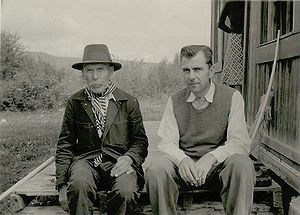Originally written in 1970
The inspiration for this article lies in a remark made by Helen Lynd in her 1958 study, On Shame and the Search for Identity, to the effect that “people of any period tend toward a kind of temporal centrism, which may be as confined in outlook as ethnocentrism.” (1)
Lynd’s comment suggests that people who behave in a temporocentric way consider their generation to be the most significant in human history and interpret or regard events in terms of their generation’s values and experiences.
I think it about as ironic as anything could be that this generation will see a consciousness shift without parallel in human history while at the same time being one that is wiping out all centrisms as illusory and stressing unitive consciousness as being the way out of it. Unitive consciousness transcends all centrisms and dissolves them.
Thus I could make an argument that this generation’s progress will indeed be the epitome of the progress of the human race so far but such a statement would only serve to divide us from the nature and character of all other eras, past and present, and so defeats the gains that unitive consciousness will bring.
Herbert Butterfield, in a now-classic study of present-mindedness, The Whig Interpretation of History (1968), called temporocentrism “an unexamined habit of mind” and “a trick of organization,” the result of “the practise of abstracting things from their historical context and judging them apart from [it] – estimating them and organizing the historical story by a system of direct reference to the present.” (2)
The basis for asserting that people tend to maximize the glories and minimize the faults of their own era lies in asserting that people tend to maximize their own glories and minimize their own faults, and to extend this unexamined habit of thought, as Butterfield called it, to other groups with which they identify.
Social psychologists have examined this self-serving bias in considerable detail. G.W. Bradley, in 1978, reviewed recent findings on the subject and wrote: “A substantial body of literature … has demonstrated [the] tendency for individuals to make self-attributions for their own positive behaviors and external attributions for their own negativce behaviors.” (3)
Numerous experiments carried out showed individuals taking credit for their own successes and shifting blame onto others or “fate” for their failures: thus, skill and talent were adduced as reasons for success and fortune or circumstance as reasons for failure. As a union publication recently expressed it: “One person who’s hard to find is a failure who admits that he’s a self-made man.” (4)
To avoid the temporocentric contention that only twentieth-century writers have been aware of egocentrism, one might point to references to it throughout the ages. “Every way of a man is right in his own eyes,” the writer of Proverbs says. (5)
Jesus reminds us that “where your treasure is, there will your heart be also” and “out of the abundance of the heart the mouth speaketh.” (6)
Aesop, who used his Fables both for personal and for diplomatic instruction, held that “we can easily represent things as we wish them to be,” (7) an argument which he sets about to demonstrate in many of his short pieces.
Francis Bacon drew on Aesop and others to support his position that “what a man would rather were true he more readily believes.” (8)
The ground was thus well prepared by the 16th century for members of the English-speaking community to discover self-serving attitudes in their own behavioral repertoire.
Social scientists of many fields took the notion of egocentrism and applied it to different levels of what anthropologist Julian Steward called “sociocultural integration.” Steward pointed out that people, as they grew up and matured, saw themselves as members of increasingly larger and more complex groupings – the family, neighborhood, community, faith, province, nation, language group, human race, and so on. (9)
Just as individuals glorify their own successes and play down their failures, so do they extend this tendency to the group. Social scientists coined terms for group glorication as it appeared at various levels of sociocultural integration: ethnocentrism, for group-centered biases; androcentrism, for male-centered biases; and anthropocentrism, for human-centered biases.
Thus, to extend this theoretical tradition to take in the argument that people express a self-serving bias toward their age, time, or generation is not a radical departure in social-scientific terms.
It’s not important to establish whether or not there’s something like an “age” or “generation,” in the same way that there are definite language and religious groups. It’s only important to establish that people spoke in terms of their generation as having a definite character or identity, to which they could adopt an attitude.
In many ways, an individual’s generation, and the age to which it belonged, is as unique a subculture as is any class, linguistic, religious or geographic, and possesses as distinctive a set of fads and fashions, styles and vogues as any other grouping in society. (10)
Herbert Butterfield’s 1968 study of whiggism examined temporocentrism in the writings of historians and noted their tendency to favor “the side of the Protestants and whigs, to praise revolutions provided they have been successful, to emphasize certain principles of progress in the past and to produce a story which is the ratification if not the glorification of the present.” (11)
The whig historian, Butterfield maintained, “stands on the summit of the 20th century and organises his scheme of history from the point of view of his own day.” (12) Given this original bias, he says, the historian has “a magnet that can draw out of history the very things [he goes] to look for, and by a hundred quotations torn from their context and robbed of their relevance to a particular historical conjuncture [the historian] can prove that there is an anology between the ideas of [a great person] and the world of the present day, [he] can see in [that great person] the foreshadowing of the present.” (13)
Butterfield’s prescription for generational bias is a temporal relativity which is analogous to the cultural relativity which the anthropologist invokes against ethnocentrism. (14) Instead of seeing “the modern world emerge as the victory of the children of light over the children of darkness,” historians, Butterfield maintains, should attempt to see it emerge “as the result of a clash of wills, a result which often neither party wanted or even dreamed of, a result which indeed in some cases both parties would eventually have hated, but a result for the achievement of which the existence of both and the clash of both were necessary.” (15)
Butterfield’s point was not that we should substitute a new formulaic, confining bias for temporcentrism, but that we should raise our own assumptions to consciousness and accept the past on its own terms and attempt to understand it in its own context.
Footnotes
(1) Helen Lynd, On Shame and the Search for Identity. New York: Routledge, 1958, 14.
(2) Herbert Butterfield, The Whig Interpretation of History. New York: Norton, 1965, c1931, 30.
(3) G.W. Bradley, “Self-Serving Biases in the Attribution Process: A Re-examination of the Fact or Fiction Question,” Journal of Personality and Social Psychology, 36, 1978, 56.
(4) The Dry Side, August 1960.
(5) Proverbs 21:2.
(6) Matthew 6:21.
(7) Aesop, “The Lion and the Statue” in Aesop’s Fables; cited in M. Scott Buck, The Big Book of Aesop’s Fables. Comlan, 2009, 12.
(8) Francis Bacon cited in Tom Athanasiou, “Everybody Knows,” Eco Equity, April 2, 2013, at https://www.ecoequity.org/2013/04/climate-denialism-has-peaked-now-what-are-we-going-to-do/.
(9) Julian Steward, “Levels of Sociolcultural Integration: An Operational Concept,” Southwest Journal of Anthropology, 7: 374-90.
(10) S.M. Beckow, “Theories of Popular Culture,” unpublished paper, 1974.
(11) Butterfield, ibid., 9.
(12) Ibid, 12-13.
(13) Ibid., Chapter 2, at https://www.eliohs.unifi.it/testi/900/butterfield/chap_2.html
(14) Ibid., cited in Historical Studies, Vol. 17, 224.
(15) Ibid., 28.




